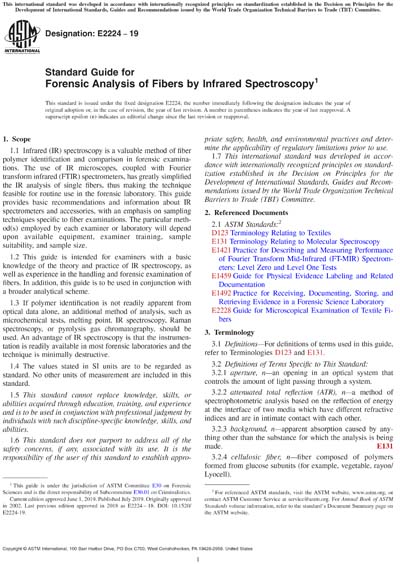Historical
ASTM E2224-19
Standard Guide for Forensic Analysis of Fibers by Infrared Spectroscopy
1.1 Infrared (IR) spectroscopy is a valuable method of fiber polymer identification and comparison in forensic examinations. The use of IR microscopes, coupled with Fourier transform infrared (FTIR) spectrometers, has greatly simplified the IR analysis of single fibers, thus making the technique feasible for routine use in the forensic laboratory. This guide provides basic recommendations and information about IR spectrometers and accessories, with an emphasis on sampling techniques specific to fiber examinations. The particular method(s) employed by each examiner or laboratory will depend upon available equipment, examiner training, sample suitability, and sample size.
1.2 This guide is intended for examiners with a basic knowledge of the theory and practice of IR spectroscopy, as well as experience in the handling and forensic examination of fibers. In addition, this guide is to be used in conjunction with a broader analytical scheme.
1.3 If polymer identification is not readily apparent from optical data alone, an additional method of analysis, such as microchemical tests, melting point, IR spectroscopy, Raman spectroscopy, or pyrolysis gas chromatography, should be used. An advantage of IR spectroscopy is that the instrumentation is readily available in most forensic laboratories and the technique is minimally destructive.
1.4 The values stated in SI units are to be regarded as standard. No other units of measurement are included in this standard.
1.5 This standard cannot replace knowledge, skills, or abilities acquired through education, training, and experience and is to be used in conjunction with professional judgment by individuals with such discipline-specific knowledge, skills, and abilities.
1.6 This standard does not purport to address all of the safety concerns, if any, associated with its use. It is the responsibility of the user of this standard to establish appropriate safety, health, and environmental practices and determine the applicability of regulatory limitations prior to use.
1.7 This international standard was developed in accordance with internationally recognized principles on standardization established in the Decision on Principles for the Development of International Standards, Guides and Recommendations issued by the World Trade Organization Technical Barriers to Trade (TBT) Committee.
Content Provider
ASTM International [astm]






